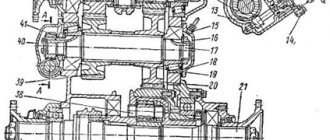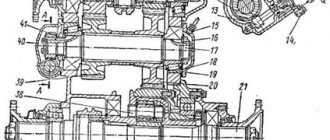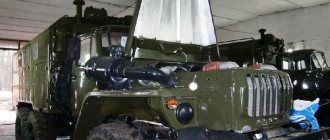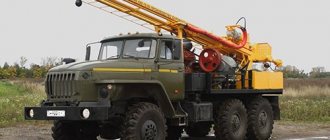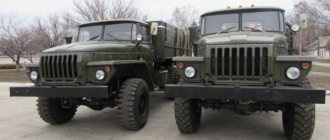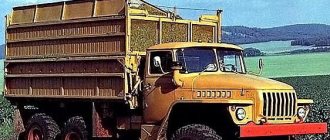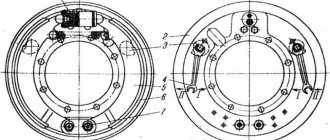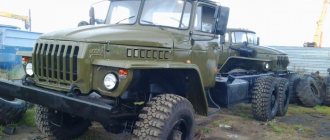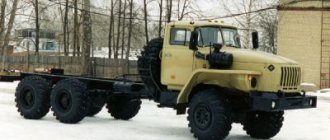KamAZ versus Ural in the army: why did the inconvenient Ural win?
Army vehicles are not just tanks. To supply the army and transport various cargoes, powerful all-terrain trucks are also needed. And both in wartime and now, the most popular vehicles in the Russian army are the Ural and KamAZ.
In war and in peacetime, vehicles are loaded not only with equipment, equipment or products: all-terrain vehicles are also suitable for transporting people. Both manufacturers - the Ural plant and the Kama plant - created machines that have all the properties necessary in wartime: -high load capacity; -power; -high cross-country ability; - ease of use.
However, experienced military personnel quickly became convinced that the trucks were very different in some respects. Ural drivers complained that driving the car was too difficult compared to KamAZ: while the vehicle produced by the Kama plant had simple and comfortable controls, the steering wheel of the Ural was considered too heavy. And this is not the only drawback: it was also noted that the steering wheel does not return to its original position on its own, which is why the driver is forced to constantly turn it. Strenuous, long hours of manual work with a clumsy, heavy wheel is a serious test.
But in addition to the fact that the driver had to constantly twist the steering wheel, he also had to be very careful with the capricious brake pedal. At the slightest pressure the car came to a sudden and complete stop.
Another unpleasant moment for Ural drivers was the following: as you know, in order for a car with a manual transmission to move, you need to squeeze the clutch - and here the drivers encountered difficulties. I had to lean into the seat to start moving, while the more agile KamAZ took off much more easily.
In terms of fuel consumption, the Ural also lost, consuming an indecent amount of gasoline compared to the competitive model.
And yet, experienced drivers always drive to the Urals. Young newcomers to the army choose KamAZ trucks, having heard a lot about the advantages of Kama vehicles over Ural ones. But why don’t old warriors ever exchange the inconvenient Urals for KamAZ?
The answer lies in the design of both cars. Initially, the Ural was conceived precisely as a transport for wartime, for use in the army. Well, KamAZ is still largely a civilian truck, modified to meet the needs of the military. What does this mean?
Firstly, the Ural has legendary all-terrain capability - no road or off-road will stop this car. It is more powerful than KamAZ.
Secondly, and this is the main advantage of the Ural, it has a hood. The driver is protected from bullets not by a sheet of metal, as in the case of KamAZ, but by the engine. Also, thanks to the voluminous hood, the driver had a chance to survive if his front wheel ran over a mine - the hood was even nicknamed the “life meter”. The cabover car left no chance. That is why the less agile and convenient Ural is held in higher esteem by the military than KamAZ.
UralZIS/Ural(UralZIS/Ural)
Miass USSR/Russia 1944-
During the Great Patriotic War, the provincial Ural city of Miass became one of the largest Soviet centers for the production of trucks, supplied primarily to the Red Army.
UralZIS-355, 1956
UralZIS-381, 4X4, 1957
Subsequently, it turned into one of the most important suppliers of military vehicles for the Soviet armed forces and the Russian army. Construction of the automobile engine plant in Miass began in December 1941 with the installation of equipment evacuated from the Moscow Automobile Plant named after I.V. Stalin (ZIS). In the spring of 1942, it began producing engines and gearboxes. On July 8, 1944, the Ural branch of ZIS, called UralZIS, began assembling 3-ton military trucks with the code ZIS-5V, known as “UralZIS-5V”. These were simplified cars with a 6-cylinder 5.56-liter engine producing 76 hp. and 4-speed transmission, wooden cab, rectangular welded fenders, flatbed with tailgate, one left headlight and no front brakes.
The improved UralZIS-5M truck with an 86-horsepower engine was produced until 1956, and its serious modernization led to the release of the UralZIS-355 model. All these vehicles were traditionally supplied to the Soviet army. In contrast, the UralZIS-355M truck, produced since 1958, with an updated appearance, was intended for work in agriculture, but in the process of working on it, an experimental version of the UralZIS-381 (4x4) was created, which passed a cycle of military tests .
Ural-375. 6X6, 1961
BM-21 Grad multiple launch rocket system on the Ural-375D chassis
Chassis "Ural-375A" with body K-375, 6X6, 1968.
In the second half of the 50s. The question urgently arose about organizing the production in Miass of a fundamentally new multi-purpose 3-axle off-road vehicle with a carrying capacity of 4~5 tons. It was planned to use it primarily for military purposes. In 1953, by order of the USSR Ministry of Defense, the Moscow Scientific Research Automotive Institute (NAMI) began to develop it. Three years later, a 5-ton NAMI-020 (6x6) truck appeared there with an experimental 180-horsepower V8 gasoline engine, power steering, all single wheels and a centralized system for regulating tire pressure on the go. After testing, it was recommended for serial production, which was supposed to be launched in Miass, where, under the leadership of chief designer S.A. Kurov, the truck was modified in accordance with test results and the requirements of military customers.
In May 1958, the first prototype of the UralZIS-NAMI-375 appeared, which received a new front facing and steering mechanism, a different front wheel drive system, a reinforced frame, unified main gearboxes, a winch and a cabin similar to the cabin of the ZIL-131 truck. Regular tests and improvements led to the creation in the summer of 1959 of the second model of the Ural-375T with its own 3-seater cabin with a canvas top and flat folding windshields. In the fall of 1960, the first Ural-375 trucks were assembled in pilot production workshops. Serial production began on January 31, 1961 at a reconstructed enterprise, which by that time had been renamed the Ural Automobile Plant (UralAZ).
For many years, the Ural-375 (6x6) became the main multi-purpose 5-ton truck of the Soviet army, the production of which in modernized versions continues to this day. At one time, its most promising design features were considered to be a new transmission concept with permanent all-wheel drive using more reliable constant-velocity disk joints in the front drive, a middle through-type axle and an asymmetrical center locking differential.
It was equipped with an overhead valve carburetor ZIL-375 V8 engine (6962 cm3, 180 hp) with aluminum cylinder heads and pistons, a dry 2-disc clutch, a manual 5-speed gearbox and a 2-speed transfer case, suspension on semi-elliptic springs, drum brakes with hydropneumatic drive and single wheels with adjustable tire pressure (0.5-3.2 kgf/cm2).
The all-metal cargo platform with a tailgate was equipped with an awning and removable benches. In 1964, production began of the most famous version of the Ural-375D with an all-metal cab and the 375S truck tractor for towing semi-trailers weighing 19.5 tons. In 1966, they were joined by the Ural-375A multi-purpose chassis for installing van bodies . At the same time, they produced the military chassis “375E” with an extended frame, the tropical version “375Yu” and the northern version “375K” for operation at temperatures down to -60 ° C. When equipped with a 7-ton rear-mounted winch, the carrying capacity of the 375 series vehicles was 4.5 tons. The Urals had a total weight of 13.3 tons, developed a maximum speed of 75 km/h, could tow trailers and implements weighing up to 10 tons and consumed on average 46~48 liters of gasoline per 100 km.
Extended chassis "Ural-375E" for missile equipment
Ural-4320, 6X6, 1977
Meteorological complex "Smile" on the chassis "Ural-4320", 6X6, 1982.
Tow truck KT-LM with armor protection on the Ural-4320 chassis, 1988.
In the armies of the USSR and socialist countries, the Ural-375D became the main middle-class truck, used for transporting personnel, various cargo, towing artillery systems and installing all kinds of bodies, military equipment and weapons. In the Soviet armed forces, the “375A” chassis was used to mount standard K-375 vans from the Shumerlinsky plant, known by the abbreviation KUNG - a universal body of normal dimensions (later - a unified sealed body). They installed equipment from headquarters, mobile radio stations, radar systems, military workshops, maintenance facilities, generator sets, weather stations, laboratories, etc.
Based on the 375 series trucks, tank trucks, fuel and oil tankers, transport-loading vehicles, and jib truck cranes 8T-210 and 9T-31/31M with a lifting capacity of 6.3~8.5 tons were produced for reloading ammunition and weapons. The extended chassis “375E” was used for the transportation and installation of large-sized military equipment, including transport and reloading equipment for missile systems and their maintenance equipment. It also produced a lightweight wheeled recovery conveyor KET-L (KT-L) with a lifting towing beam, a 1.5-ton crane and two winches with a traction force of 5 and 15 tf. In 1963, the 122-mm BM-21 Grad multiple launch rocket system was adopted. She first appeared at the anniversary parade on November 7, 1967 in Moscow. Launcher 9K51, developed by the parent enterprise of the State Research and Production Enterprise "Splav" under the leadership of A. N. Ganichev and produced since 1965.
Motovilikha plants, was mounted on the Ural-375D chassis. It had a package of 40 tubular guides 3 m long, installed on a turntable with lifting and turning mechanisms. With the simultaneous launch of 40 unguided missiles, it ensured the destruction of manpower and equipment at a distance of up to 21 km and over an area of over 1000 square meters. m. Grad combat vehicles are recognized as one of the most successful and were supplied to 40 countries around the world.
The next stage in the development of military vehicles of the Ural Automobile Plant is associated with the release in 1977 of the new 5-ton army truck "Ural-4320" (6x6), which was a diesel version of the 375 series, equipped with a more economical KamAZ-740 V8 engine (10852 cm3, 210 hp). Externally, it was distinguished by a modified radiator grille with wide vertical slots, and also received a reinforced transmission, modernized chassis units, a winch with a pulling force of 9 t and 24-volt electrical equipment.
The more powerful Ural-4320, with its gross weight increased to 13.8 tons, could operate at an altitude of more than 4,500 m above sea level, overcome an elevation of 31° and a 1.5-meter ford, and reach a maximum speed of 85 km/h. Since 1978, the 4420 truck tractor was produced on its basis. Like its predecessor, the Ural-4320 was equipped with a variety of military equipment. It mounted standardized vans KTs-4320 with various equipment and isothermal AFI-5, kitchen-dining rooms KSA-200, fuel and oil tankers, engineering equipment, etc.
Combat vehicle BM-21PD “Damba” on the Ural-4320 chassis, 1990.
Ural-43223, 6X6, 1992
Ural-43206-0651, 4X4, 2004
Ural-43206-47, 4X4, 2004
Ural-4320-31, 6x6, 1995
"Ural-4320B" with local armor protection, 6x6, 1998
This chassis became the base of the MTP-A1 technical assistance vehicle with a winch, hydraulic crane, a set of special tools, refueling fluids, as well as a modernized KT-LM wheeled tow truck with local armor protection. The latter was used to tow faulty wheeled vehicles weighing up to 15.2 tons in a semi-submerged position, for which it was equipped with a towing device, a pushing bumper for clearing the path, a 7-ton winch and rigging devices. The “4320” chassis was equipped with an upgraded BM-21-1 “Grad” multiple launch rocket system with a firing range of 40 km, an experimental 50-round launcher 9K59 “Prima” (1988), as well as a 40-round BM-21PD “ Dam" (DP-62) for protecting naval bases, structures and sea borders from enemy sabotage forces and means, allowing them to be destroyed at a distance of up to 5 km and at a depth of 200 m. Reinforced chassis "Ural 5557", unified with the "series" 4320", was used for the installation of truck cranes, excavators, engineering equipment and the transportation of heavy equipment.
Perestroika and economic reforms of the 80-90s, when the flow of military orders practically dried up, led to the reorientation of UralAZ JSC to the primary production of civilian products, however, unlike most other automobile plants of the former USSR, specialists from Miass continued to be actively involved in the creation modernized and fundamentally new models of military trucks. In June 1992, production began of the 6-ton Ural-43223 (6x6) flatbed vehicle, which stood out for its new rectangular front fascia and cab with an enlarged windshield.
Its feature was the Ural-744 V8 air-cooled engine with a power of 234 hp, assembled by the Kustanai Diesel Plant (KDZ) under a German license (Deutz). Soon after the collapse of the USSR, this enterprise ceased operations, but a batch of 6.5-ton chassis “43223” with an 8-ton winch, on which standard vans were mounted, entered the armed forces.
Chassis "Ural-43203-31" (6x6) with a replaceable container, 2003
Ural-4320-0911-30, 6X6, 1996
Chassis "Ural-5557" (6X6) with army crane KS-2573, 1985.
"Ural-379" (6X6) and "Ural-395" (8X8), 1972
A major fire that occurred in the spring of 1993 at the engine production of the Kama Automobile Plant forced UralAZ specialists to urgently look for a replacement for the diesel engines produced there, which unexpectedly led to the expansion of the production program. Already in 1993, vehicles with the additional index “10” appeared, equipped with a YaMZ-236M2U6 diesel engine (11.2 l, 180 hp) from the Yaroslavl Motor Plant, - a 5-ton truck “Ural-4320-10”, a truck tractor “ 44202-10", chassis "43203-10" and long-wheelbase version "4320-0911-10". In 1995, on their basis, a 4-ton two-axle army truck “Ural-43206” (4x4) was created, unified with 3-axle vehicles and becoming the basis for field radio stations, tanks and special equipment. With the installation of the new YaMZ-238M2 V8 diesel engine (14.9 l, 240 hp) on the “4320” (6x6) chassis, the cars received the index “31” and were externally distinguished by an elongated hood.
The main representative of this series was the 6-ton army truck “4320-31” with a total weight of 15.2 tons, developing a maximum speed of 82 km/h. Since 1995, it has been in service with the Russian Army. Subsequently, the plant’s military program included the “44202-31” truck tractor and the “5557-10/31” multi-purpose chassis with a distance between the front and middle axles of 3525 mm, as well as long-wheelbase 10-ton models “4320-0911/0919-30” " and 12-ton "4320-1911/1912-10/30", in which this figure reached 4555 mm. The "43203-31" chassis offers the MTP-A2.1 technical assistance vehicle and container reloaders, and the long-wheelbase chassis has become the basis for heavy military equipment and tankers. Army Ural vehicles have a special paint job, brackets for mounting small arms in the cabin, a set of blackout devices and night vision devices, and an underbody light. Since the late 90s. Based on the “4320” series, several variants were created with armored cabins, an engine compartment and capsules on a cargo platform. In 2006, the 400-horsepower Ural-6320 (6x6) truck of a new modular family was introduced.
Back in the mid-60s. NAMI and the Ural Automobile Plant began the development of a promising cabover family of unified multi-purpose off-road vehicles with a cab over the engine. The first Ural-379 (6x6) and Ural-395 (8x8) trucks appeared in 1972-74, and the second option with the experimental YaMZ-741 V10 diesel engine was considered the most promising. The continuation of this work dates back to the mid-80s, when the USSR Ministry of Defense developed technical specifications for 4-axle army vehicles. In 1989, the plant introduced the 9-ton Ural-5323 (8X8) truck with a 260-horsepower engine, a 5-speed gearbox and a cab from KamAZ vehicles, its own 2-speed transfer case, a tire inflation system, front and rear balancing pendant.
Ural-5323-20, 8X8, 1993
Ural-5423-20, 8X8, 1994
Anti-aircraft complex "Pantsir-S1" on the Ural-53234 chassis, 1995.
Ural-532301, 8X8, 2003
In the mid-90s. on the “53232” model, this power unit was replaced with a 290-horsepower air-cooled Ural-745 diesel engine, and then on the “5323-20” truck a 300-horsepower YaMZ-238B V8 with turbocharging appeared, working with an 8-speed gearbox, which made it possible to increase the load capacity to 10 tons and increase the steepness of the climb to 58%. Since 1995, a cabin has been installed, which is assembled in Miass under license from the IVECO Corporation. At the end of the 90s. For the armed forces, the "5323" series was offered in the "532301/02" flatbed versions with a metal cargo platform and awning, a short or long cab with a berth, and also as a 15-ton engineering chassis "532361/62". This series was supplemented by the “5423-20” truck tractor for towing semi-trailers weighing up to 40 tons and several options with local armor.
In 1995, on the “53234” chassis, a sample of the Pantsir-S1 short-range anti-aircraft missile and gun system was created to protect strategically important objects from high-precision weapons, capable of simultaneously hitting up to 12 targets at a distance from 200 m to 12 km and at an altitude of 8 km. Its armament consisted of two 30 mm cannons and 12 anti-aircraft guided missiles installed in the turret superstructure. In 1998, UralAZ was awarded the State Prize of the Russian Federation for the creation and implementation of a family of dual-purpose vehicles.
The beginning of the 21st century for the enterprise, renamed OJSC Avtomobilny (A3 Ural), is associated with the creation and implementation of new models of military and civilian all-wheel drive vehicles.
230 hp with turbocharging and intercooling, including army trucks "43206-41" (4x4) and "4320-41" (6x6), chassis "43203-1911-40" and "5557-40" (6x6) , as well as multi-purpose 300-horsepower chassis “5323-41” and “5323-42” (8x8) with short and extended cabs. All of them were tested by the Ministry of Defense for adoption by the Russian Army. In the early 2000s. also presented a number of new army vehicles: the flatbed truck “43206-47” (4×4) with an IVECO cab and a 250-horsepower diesel engine YaMZ-236BE2 (Eigo-2), the hood version “4320-45” (6x6) with new cabin and tail, chassis “632361” (10×10) and “692341” (10×8) with a 300-horsepower diesel engine and a reloader for light armored vehicles.
Table of contents
A daily boost of fighting spirit!WARHEAD.SU
At the ongoing international military-technical forum "Army-2018", two armored vehicles appeared nearby. Even the names, which differ only by one letter, indicate the similarity of the machines in purpose. And also manufacturing plants. Ural-63095 Typhoon-U was made at the Ural Automobile Plant, and KAMAZ-63968 Typhoon-K, of course, was made on the Kama River.
Ural-63095 “Typhoon-U” (photo: Andrey Bekasov/WARHEAD.SU)
KAMAZ-63968 “Typhoon-K” (photo: Andrey Bekasov/WARHEAD.SU)
So let's try to compare them - as they say, by eye.
Entrance
The theater begins with a hanger, and an armored car for transporting personnel begins with a ramp. As you can see, the Typhoon-U has a large part - it even has an additional step. Climbing it will not be a problem even for children.
“Typhoon-U” (photo: Andrey Bekasov/WARHEAD.SU)
The KAMAZ vehicle has a noticeably smaller ramp, has no steps, and its edge from the ground (in this case, the concrete block) is noticeably higher. Even grown men jumped on her with some effort. How a fighter, hung from head to toe with weapons and equipment, will conquer this height is an interesting question. Especially if before loading he gets tired and can barely drag his feet - this sometimes happens in the army.
"Typhoon-K" (photo: Andrey Bekasov/WARHEAD.SU)
Seats in the cabin
If the serviceman does conquer the ramp, everything magically changes. Look at how cheerful green seats KAMAZ has! They even look soft.
"Typhoon-K" (photo: Andrey Bekasov/WARHEAD.SU)
And what boring black poggio... seats the Typhoon-U has! Our “fairy” for them! Although... let's take a closer look.
“Typhoon-U” (photo: Andrey Bekasov/WARHEAD.SU)
Can you see the footrest? You can put it, you can catch it. A small thing... but when detonated by a landmine, even small things matter. Let's look further.
“Typhoon-U” (photo: Andrey Bekasov/WARHEAD.SU)
No, this is not an oddly shaped coffee stand. More precisely, a stand, but not for coffee, but for a butt.
“Typhoon-U” (photo: Andrey Bekasov/WARHEAD.SU)
There is also a top mount.
“Typhoon-U” (photo: Andrey Bekasov/WARHEAD.SU)
But the next car has nothing like that. And there’s nowhere to sit - the seats are pressed too closely together.
"Typhoon-K" (photo: Andrey Bekasov/WARHEAD.SU)
Moreover, when two people sit on opposite seats, their knees become a little cramped. And where to put the machine gun or machine gun in this case is an interesting question.
"Typhoon-K" (photo: Andrey Bekasov/WARHEAD.SU)
Cabin
No, well, we need to somehow dilute this boring blackness, the designers from the Urals decided. Give me colorful wires! Lots of wires! A soldier can’t get confused in them, right? All of our military personnel have a smooth, streamlined uniform—as agile as devils.
“Typhoon-U” (photo: Andrey Bekasov/WARHEAD.SU)
We'll also add some cords to the front so that it's not boring at all.
“Typhoon-U” (photo: Andrey Bekasov/WARHEAD.SU)
Whether it's the competitors - almost everything has been removed somewhere behind a plastic panel. There is nothing to catch your eye on. Automatically, too, though.
"Typhoon-K" (photo: Andrey Bekasov/WARHEAD.SU)
In general, if you are seriously planning to go to war and are deciding what to go with, now is the time to think. Including about things that are usually not written on any signs.
And in the remaining days you can have time to personally climb both cars and add your pros and cons to our comparison.
And remember: “ergonomics” is not a dirty word!
Ural-43203
| The section lacks links to sources. Information must be verifiable or it may be deleted. You can |
Motovoz-M.
- Ural-4320-****-**
- chassis with a standard (“classic”) metal cabin, with a load capacity of about 7-9 tons; - Ural-4320-19**-**
- long-wheelbase chassis, with a load capacity of about 12 tons; - Ural-43203-****-**
- chassis with reinforced front suspension; - Ural-43204-****-**
- chassis of a pipe-weaving tractor, increased load capacity; - Ural-44202-****-**
- truck tractor for operation with a semi-trailer on all types of roads; - Ural-5557/55571-****-**
- chassis for mounting technological equipment and special installations weighing ~12-14 tons with low-profile wide tires with adjustable wheel inflation, which significantly increases the vehicle’s cross-country ability;
"Ural-43206" at the parade (Eastern Military District)
- Ural-43206-****-**
- chassis with a 4 × 4 wheel arrangement; new fuel injection system - reduced consumption; increased wheelbase (4405 mm versus 3525 mm for the Ural-4320) [2]
Cockpit and tail options:
- Ural-4320*/5557*-****-40/41
- all-metal, three-seater, two-door cab, also under the index there are vehicles with a double four-door cab; - Ural-4320*/5557*-****-42/44
- all-metal, three-seater, two-door cabin with a sleeping bag. Currently discontinued; - Ural-4320*/5557*-****-48/58/59
- version with a new more voluminous comfortable hood-type cabin, plastic tail, sprung driver's seat; - Ural-4320*/5557*-****-70/71/72/73/74/75
- version using the Gazelle Next cabin module, can be three-seater or seven-seater;
All versions can also be equipped with IVECO cabover cabs.
Armored army modifications
Ural-4320-09-31
An armored vehicle based on the Ural-4320-31 with a cabin molded from a single armored sheet, with armored glass, embrasures for firing, powerful safe doors equipped with locks with internal locking.
The cabin floor, rear wall and roof are also made of armor plate, and there is an armored hatch in the roof that can be used as a machine gun nest. The cabin became double, with separate seats. In the vacant space, special equipment was installed: night vision devices, radiation and chemical reconnaissance, an army radio station, etc. In addition to the usual “stove,” a filter and ventilation unit (FVU) is mounted on the roof.
The car is equipped with a steel “mask” on the radiator; the sides and hood are made of armor plate. The battery box and fuel tank are also armored. An armored module for 15-20 soldiers can be installed in the body under the awning. There are only wooden benches inside.
Ural-E4320D-31 (Ural-4320-0010-31)
An armored multi-purpose vehicle of the unified Motovoz-1 family with an armored functional module installed on the vehicle platform, designed for transporting various cargo, personnel and towing trailer systems on all types of roads and terrain. Developed on the basis of the Ural-4320-31 type 6 × 6 vehicle. The armored vehicle has increased protection from small arms fire and mine resistance. It was first presented at the Russian Expo Arms-2009
in Nizhny Tagil. On June 10, 2011, at a display of military equipment at the training ground of NIIITS AT 3 Central Research Institute of the Ministry of Defense of the Russian Federation in Bronnitsy, the car was presented as Ural-4320-0010-31.
Casspir Mk6
Armored vehicle MPVI
(eng. Mine Protected Vehicle for India), manufactured at the joint venture
Defense Land Systems India (DLSI)
at the
Mahindra & Mahindra
plant in Prithla near Faridabad (Haryana). The order of these six vehicles by the government of Jharkhand was due to the need to combat pro-Maoist rebel groups operating in the state.
The vehicle is made in the form of a structure based on an all-welded V-shaped body and the base of the chassis of trucks of the Ural-4320 family. Modifications are offered with 4 × 4 and 6 × 6 wheel arrangements, equipped with a YaMZ-236NE2 turbocharged diesel engine (maximum power 230 hp / 169 kW) and a YaMZ-236U manual transmission. This solution was chosen to reduce the cost of the machine, the cost of which is stated to be from 350 thousand dollars. According to a statement by the director of business development of BAE Systems Land Systems South Africa
Johan Jooste, “the use of Ural elements made it possible to reduce the cost by a third.”
In the 6 × 6 version, the vehicle has a length of 7.59 m, a width of 2.67 m, a ground clearance of 380 mm, and a combat weight of 14.32 tons. The armored vehicle can accommodate up to 18 personnel, placed in individual suspended shockproof seats and can be configured in the form of an armored personnel carrier, multi-purpose or command vehicle. It is stated that during testing, the vehicle withstood, without harm to personnel, the detonation of a twenty-one-kilogram charge under the wheel (the accuracy was confirmed by a video of the corresponding tests posted on the Internet [3]) and a fourteen-kilogram charge under the body of the vehicle. It is possible to attach additional ballistic protection[4].
Ural-432009
Main article: Ural-432009
"Ural-432009"
Ural-4320ВВ:
- Media files on Wikimedia Commons
The armored vehicle was designed according to the technical specifications of the Main Command of the Internal Troops of the Ministry of Internal Affairs of Russia on the basis of the chassis of the Ural-4320 6 × 6 multi-purpose vehicle. The armored vehicle is equipped with a YaMZ engine of the Euro-4 standard, has mine protection and is made with a single-volume armored body that can accommodate up to 17 fighters with full weapons. The layout of the armored vehicle is free, which makes it possible to install various variants of combat modules and equipment on it, depending on the assigned operational tasks.
The car was first presented in 2013 at the Russian Arms Expo-2013
in Nizhny Tagil. This vehicle will become the basis for a whole family of tactical protected vehicles, which have a high degree of unification and are distinguished by different wheel formulas.
"Federal-M"
"Federal-M"
Development of the idea Ural-432009. The vehicle was exhibited at the Army 2020 forum.
Specifications
The basis of the vehicle is an all-welded iron frame, which is highly durable. Single wide wheels with all-wheel drive provide stability on the highway and good cross-country ability off-road.
TTX Ural-4320:
- length - 740 cm;
- width - 250 cm;
- height - 290 cm;
- wheelbase - 360 cm;
- rear and front track - 200 cm;
- ground clearance - 40 cm;
- minimum turning radius - 1150 cm;
- weight of a military vehicle with refueling - 8000 kg;
- load capacity - 6850 kg,
- towed trailer weight - 11500 kg;
- seats for transporting passengers - 27-36.
During the production period the following modifications of military vehicles were produced:
- with an extended body;
- with reinforced front suspension;
- with increased load capacity;
- tractor unit;
- lightweight with a 4x4 wheel arrangement.
The base model remains a body version with an awning, intended for transporting cargo and personnel.
Transmission
The Ural truck has a 6x6 wheel arrangement. Each wheel is equipped with an automatic inflation and maintenance system for air pressure. The dependent front suspension is mounted on semi-elliptical springs with shock absorbers. The rear wheels are mounted on springs with reaction bars. The disc clutch is equipped with a friction drive and a pneumatic booster.
The gearbox is mechanical. There are 10 forward and 2 reverse speeds. The transfer mechanism is synchronized and has 2 gears. It contains a center differential lock that evenly distributes torque between the front axle and the rear bogie. The transmission of draft force is carried out through 4 cardan shafts.
Brake system
The main dual-circuit hydraulic system with all-wheel drive. Slowing down the speed and stopping the machine is carried out by single or multiple pressing of the foot on the pedal located in the floor of the cabin. Drum brakes, 2 pads on each wheel.
The spare system is single-circuit. It turns on automatically when the main mechanism fails.
The auxiliary unit is pneumatic and operates from the exhaust system.
The drum-type parking brake is installed on the transfer case shaft. Ensures that the machine is held on a slope or stopped at low speed in the event of a breakdown of the main and backup systems.
Engine
The first models of the army all-terrain vehicle were equipped with KamAZ-740.10 engines from the Kama Automobile Plant. The engine had 8 cylinders with a total volume of 10.9 liters and a power of 230 hp. Subsequently, designers began to equip the Urals with a YaMZ power unit from the Yaroslavl Motor Plant. The latest models are equipped with 238 series motors.
The technical characteristics of this engine are as follows:
- type - V-shaped diesel;
- number of cylinders - 8;
- rated power - 240 hp;
- working volume - 14.86 l;
- number of revolutions per minute - 2600;
- maximum torque - 882 Nm;
- cooling - liquid forced;
- power supply system - mechanical in-line injection pump;
- maximum speed - 85 km/h;
- fuel consumption per 100 km - 32-40 l;
- fuel tanks - main 300 l and additional 60 l;
- climbability - 58%;
- Power reserve - 1000 km.
The power unit is equipped with a heating device for starting in the cold season. The engine is installed under the hood, located in front of the cab. Modern models are equipped with an aerodynamic bumper with an optical system. The cabin is finished with plastic fairings that reduce drag and give the car an attractive appearance.
Transportation options
The floor of the base model is made of sheet metal 3-4 mm thick. The side opens backwards, there are folding chairs in the body, and provision for fastening benches. The side boards are solid or lattice panels. The vehicle is capable of transporting up to 36 lightly equipped or 24 fully equipped military personnel.
The durable frame and suspension can withstand heavy piece or bulk cargo. On the platform of the car you can attach a change house, a passenger compartment with chairs, a repair shop or a hospital ward. If there are guy ropes, it is possible to transport machines and industrial equipment. A truck is used to transport food, consumer goods and other materials.

